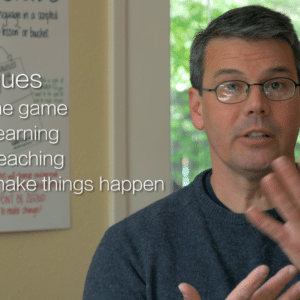
Bite-sized pieces may vary from person to person. It's better for your digestion to err on the side of smaller.
In order to keep players fluently participating in the game, you ensure all new information emerges in bite-sized pieces.
Q: “How do you eat an elephant?” A: “One bite at a time.”
Massively complex skills or projects are almost effortless when tackled one bite at a time. Once you’ve learned this technique, you’ll begin to see it everywhere you see fluent skills and successful behaviors. It’s an eminently obvious technique – yet it can be fiendishly difficult to apply. Aside from early childhood, a typically schooled person has almost no experience applying this to their own learning. We’re used to swallowing oceans of information, and regurgitating it, without actually digesting it. We have chronic learning bulimia.
The art (and science) of slowing down, and honestly earning each new piece of fluent skill, each new piece of information, seems to take quite a bit of discipline – and yet it delivers such startling progress.
Bite-sized pieces may vary in size according to the players in front of you – although you’ll gain skill in WAYK faster if you use the smallest functional bite-sized piece, in order to get used to what most players will need. Having said that, it is important to recognize that a mouse has smaller bite-sized pieces than a wolf that bolts down parts of its meal whole, smaller than snake that can unhinge its jaw. As you gain experience, you’ll know when you can increase the size of the pieces you feed yourself and other players.
Introducing the technique to language acquisition
Short: “Technique: Bite-sized Pieces. We’ll add new language one piece at a time.”
Applying the technique to language acquisition
The first time you add a second bite-sized piece to play, introduce this technique. Then mark each new piece until the players become familiar with the rhythm of play – one bite-sized piece at a time, played until ready to add another.
- Each introduced Craig’s List is a bite-sized piece unto itself. Each word in a Craig’s List is a conversational bite-sized piece, often requiring a trip around the table in threes.
- Bite-sized pieces usually are measured by the ability of players to gain a minimum of confidence in them after going around the table in threes alternating my turn/your turn at least once.
- You’ll know you may need a smaller bite-sized piece if the players display any signs of sorry, charlie or full – blank stares, widened eyes, gaping mouths, or hands on laps.
- As always, add each new bite-sized piece by first starting at the beginning.
But what about…?
New players may wish to increase the size of new pieces of information to what they may be more familiar with from classroom language learning – long lists of words, and several different conversation topics.
If you don’t call limit on these requests, you’ll have a front row seat to the amount of deceleration this causes your game. Games often stop in mid-play when the added piece is no longer bite-sized. Limit is the over-arching game rule, and the size of that limit for new language is bite-sized pieces.




